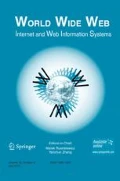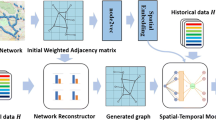Abstract
Private car transfer indicates that people drive private cars and travel between urban regions to perform daily activities. Foreseeing private car transfer between urban regions can facilitate a broad scope of applications ranging from route planning, hot region discovery to urban computing. However, three challenges remain. i) Private car transfer between regions is affected by multiple spatio-temporal correlations. ii) Transfer records are highly sparse and imbalanced. iii) Modeling the stay duration of private cars. In this paper, we model private cars’ travel in urban regions as the spatio-temporal graph and formulate private car transfer foreseeing as the time-evolving adjacency matrix prediction of the graph. To specify, we propose MG-GAN (Multiple Graph-based Generative Adversarial Network) to predict private car transfer. For one thing, we design multi-graph dense convolutions with gated recurrent networks as the generative network to capture multiple spatio-temporal correlations. For another, the attentive multi-graph convolutional network is designed as the discriminative network to learn the stay duration correlations of private cars in each region. The iterative adversarial processes between generating and discriminating networks enhance the MG-GAN’s ability to tackle the sparse data problem. Besides, a topic clustering algorithm based on multi-source data fusion is proposed to balance the fused data. Extensive experiments on the real-world private car and taxi trip datasets demonstrate that MG-GAN performs better than the state-of-the-art baselines.







Similar content being viewed by others
References
Alexander, L., Jiang, S., Murga, M., González, M.C.: Origin-destination trips by purpose and time of day inferred from mobile phone data. Transp Res Part C: Emerg Technol 58, 240–250 (2015)
Alfeo, A.L., Cimino, M.G., Egidi, S., Lepri, B., Vaglini, G.: A stigmergy-based analysis of city hotspots to discover trends and anomalies in urban transportation usage. IEEE Trans Intell Transp Syst 19(7), 2258–2267 (2018)
Arthur, D., Vassilvitskii, S.: k-means++: the advantages of careful seeding. In: ACM SIAM, New Orleans, Louisiana, USA, pp. 1027–1035. Stanford (2007)
Bartle, C., Chatterjee, K.: Employer perceptions of the business benefits of sustainable transport: a case study of peri-urban employment areas in south west england. Transp Res A Policy Pract 126, 297–313 (2019)
Blei, D.M., Ng, A.Y., Jordan, M.I.: Latent Dirichlet allocation. J Mach Learn Res 3, 993–1022 (2003)
Chai, D., Wang, L., Yang, Q.: Bike flow prediction with multi-graph convolutional networks. In: ACM SIGSPATIAL, pp. 397–400 (2018)
Cheung, M., Shi, J., Wright, O., Jiang, L.Y., Liu, X., Moura, J.M.: Graph signal processing and deep learning: convolution, pooling, and topology. IEEE Signal Process Mag 37(6), 139–149 (2020)
Chu, K.F., Lam, A.Y., Li, V.O.: Deep multi-scale convolutional lstm network for travel demand and origin-destination predictions. IEEE Trans Intell Transp Syst 21(8), 3219–3232 (2020)
Geng, X., Li, Y., Wang, L., Zhang, L., Yang, Q., Ye, J., Liu, Y.: Spatiotemporal multi-graph convolution network for ride-hailing demand forecasting. In: AAAI, vol 33, pp. 3656–3663 (2019)
Gong, Y., Li, Z., Zhang, J., Liu, W., Zheng, Y.: Online spatio-temporal crowd flow distribution prediction for complex metro system. IEEE Trans Knowl Data Eng, pp. 1–16 (2020)
Hu, J., Yang, B., Guo, C., Jensen, C.S., Xiong, H.: Stochastic origin-destination matrix forecasting using dual-stage graph convolutional, recurrent neural networks. In: IEEE ICDE, pp. 1417–1428 (2020)
Huang, G., Liu, Z., Van Der Maaten, L., Weinberger, K.Q.: Densely connected convolutional networks. In: CVPR, pp. 2261–2269 (2017)
Huang, Y., Xiao, Z., Wang, D., Jiang, H., Wu, D.: Exploring individual travel patterns across private car trajectory data
Inman, J.: Navigation and nautical astronomy, for the Use of British Seamen. F. & J Rivington (1849)
Kipf, T.N., Welling, M.: Semi-supervised classification with graph convolutional networks. ICLR, pp. 1–14 (2017)
Lei, K., Qin, M., Bai, B., Zhang, G., Yang, M.: Gcn-gan: a non-linear temporal link prediction model for weighted dynamic networks. In: IEEE INFOCOM. Paris, pp. 388-396 (2019)
Li, Y., Fu, K., Wang, Z., Shahabi, C., Ye, J., Liu, Y.: Multi-task representation learning for travel time estimation. In: ACM SIGKDD, pp. 1695–1704 (2018)
Lin, Z., Feng, J., Lu, Z., Li, Y., Jin, D.: Deepstn+: context-aware spatial-temporal neural network for crowd flow prediction in metropolis. In: AAAI. Honolulu, pp. 1020–1027 (2019)
Liu, C., Cai., J., Wang, D., Tang, J., Wang, L., Chen, H., Xiao, Z.: Understanding the regular travel behavior of private vehicles: An empirical evaluation and a semi-supervised model. IEEE Sensors J 21(17), 19078–19090 (2021)
Liu, C., Wang, D., Chen, H., Li, R.: Study of forecasting urban private car volumes based on multi-source heterogeneous data fusion. J Commun 42 (3), 54–65 (2021). https://doi.org/10.11959/j.issn.1000-436x.2021018
Liu, W., Lai, H., Wang, J., Ke, G., Yang, W., Yin, J.: Mix geographical information into local collaborative ranking for poi recommendation. World Wide Web 23(1), 131–152 (2020)
Moreira-Matias, L., Gama, J., Ferreira, M., Mendes-Moreira, J., Damas, L.: Time-evolving od matrix estimation using high-speed gps data streams. Expert Syst Appl 44, 275–288 (2016)
Nasab, M.R., Shafahi, Y.: Estimation of origin-destination matrices using link counts and partial path data. Transportation 47(6), 2923–2950 (2020)
Shen, B., Liang, X., Ouyang, Y., Liu, M., Zheng, W., Carley, K.M.: Stepdeep: a novel spatial-temporal mobility event prediction framework based on deep neural network. In: ACM SIGKDD. London, pp. 724–733 (2018)
Shi, H., Yao, Q., Guo, Q., Li, Y., Zhang, L., Ye, J., Li, Y., Liu, Y.: Predicting origin-destination flow via multi-perspective graph convolutional network. In: IEEE ICDE, pp. 1818–1821 (2020)
Shi, X., Chen, Z., Wang, H., Yeung, D.Y., Wong, W.K., Woo, W.C.: Convolutional lstm network: a machine learning approach for precipitation nowcasting. Adv Neural Inform Process Syst 2015, 802–810 (2015)
Simini, F., González, M.C., Maritan, A., Barabási, A.L.: A universal model for mobility and migration patterns. Nature 484(7392), 96–100 (2012)
Wang, D., Wang, C., Xiao, J., Xiao, Z., Chen, W., Havyarimana, V.: Bayesian optimization of support vector machine for regression prediction of short-term traffic flow. Intell Data Anal 23(2), 481–497 (2019)
Wang, Y., Yin, H., Chen, H., Wo, T., Xu, J., Zheng, K.: Origin-destination matrix prediction via graph convolution: a new perspective of passenger demand modeling. In: ACM SIGKDD, pp. 1227–1235 (2019)
Yang, M., Liu, J., Chen, L., Zhao, Z., Chen, X., Shen, Y.: An advanced deep generative framework for temporal link prediction in dynamic networks. IEEE Trans Cybern 50(12), 4946–4957 (2019)
Yao, H., Tang, X., Wei, H., Zheng, G., Li, Z.: Revisiting spatial-temporal similarity: a deep learning framework for traffic prediction. In: AAAI. Honolulu, pp. 5668–5675 (2019)
Zhang, J., Zheng, Y., Sun, J., Qi, D.: Flow prediction in spatio-temporal networks based on multitask deep learning. IEEE Trans Knowl Data Eng 32(3), 468–478 (2019)
Zhang, M., Li, T., Li, Y., Hui, P.: Multi-view joint graph representation learning for urban region embedding. In: IJCAI. Yokohama, pp. 4431–4437 (2021)
Zhang, Y., Wang, S., Chen, B., Cao, J., Huang, Z.: Trafficgan: network-scale deep traffic prediction with generative adversarial nets. IEEE Trans Intell Transp Syst 22(1), 219–230 (2021)
Zheng, L., Xia, D., Chen, L., Sun, D.: Understanding citywide resident mobility using big data of electronic registration identification of vehicles. IEEE Trans Intell Trans Syst 4363–4377 (2019)
Acknowledgments
This work was supported in part by the Humanities and Social Sciences Foundation of MOE under grant 21YJCZH183, in part by the Key Research and Development Project of Hunan Province of China under Grant 2021GK2020, and in part by the Funding Projects of Zhejiang Lab under grants 2021LC0AB05 and 2020LC0PI01.
Author information
Authors and Affiliations
Corresponding authors
Additional information
Publisher’s note
Springer Nature remains neutral with regard to jurisdictional claims in published maps and institutional affiliations.
This article belongs to the Topical Collection: Special Issue on Computational Aspects of Network Science
Guest Editors: Apostolos N. Papadopoulos and Richard Chbeir
Rights and permissions
About this article
Cite this article
Liu, C., Xiao, Z., Wang, D. et al. Foreseeing private car transfer between urban regions with multiple graph-based generative adversarial networks. World Wide Web 25, 2515–2534 (2022). https://doi.org/10.1007/s11280-021-00995-z
Received:
Revised:
Accepted:
Published:
Issue Date:
DOI: https://doi.org/10.1007/s11280-021-00995-z




